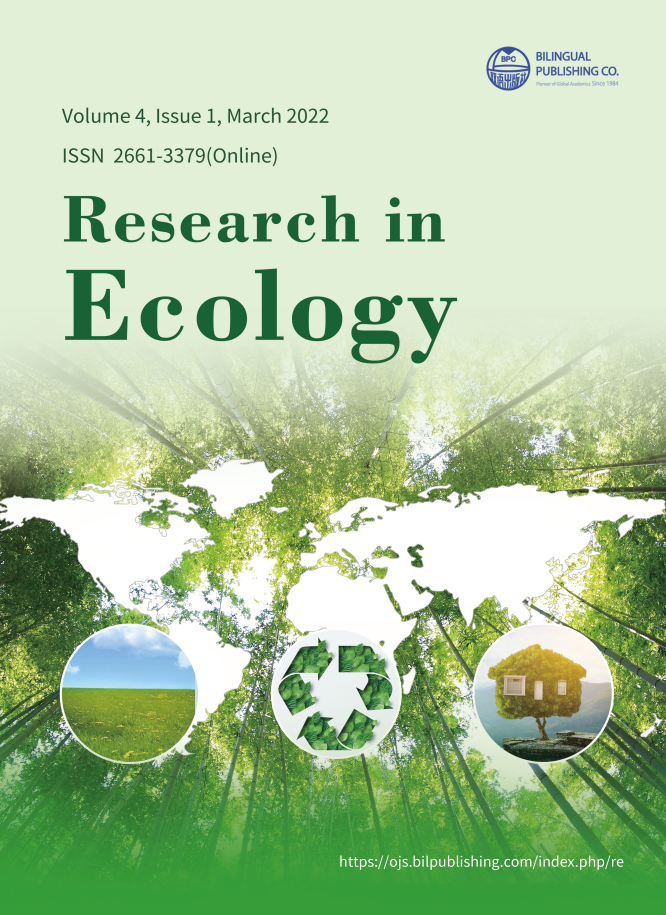
Relationship between Physico-Chemical Parameters and the Population Distribution of Fresh Water Snails in Amassoma Community and Niger Delta University Campuses, Bayelsa State, Nigeria
DOI:
https://doi.org/10.30564/re.v4i1.3773Abstract
Evaluating the presence of fresh water snails in a location is germane in establishing a snail-borne disease control program. The purpose of the study was to see how physicochemical parameters influenced the population distribution of four fresh water snails (Lymnaea natalensis, Bulinus globosus, Biomphalaria pfeiffer, and Melanoides spp.) in the Amassoma community and Niger Delta University between March, 2021 and May 2021. Snails were gathered by plucking and scooping them by hand. Snail was identified using standard pictorial keys. Physicochemical of the water of the snail habitat were measured using standard in-situ apparatus across eight sites. Physico chemical measured were temperature, pH, conductivity, BOD, turbidity, salinity, and alkalinity. A total of 258 snails were gathered from the eight (8) different sites. In all sites, Lymnaea natalensis was more abundant. Bulinus globosus, Biomphalaria pfeiffer, and Melanoides spp. were among the other snails discovered. Lymnaea had negative correlation with pH, conductivity, BOD, and alkalinity and a positive correlation with salinity and temperature. Bulinus had a positive relationship with pH, salinity, and conductivity and a negative correlation with temperature, turbidity, BOD, and alkalinity. Biomphalaria had a positive correlation with temperature, pH, salinity, turbidity, and alkalinity Melanoides had positive correlations with Temperature, pH, salinity, BOD, and alkalinity and a negative correlation with turbidity and concentration. The was correlation between snails and snails. The presence of these snails suggests that the Amassoma village and Niger Delta University campuses are potential hotspots for a variety of snail-borne diseases.
Keywords:
Physico-chemical parameters; Population distribution; Fresh-water snail; Amassoma community; Niger Delta UniversityReferences
[1] Yves, B.K., Edia, E.O., Felix, K.K., Cyrille, K.N., Dramane, D., Allassana, O., 2013. Spatial Distribution Africa Pattern of Freshwater Mollusks in Me, Agenby and Banco Basin (Ivory Coast; West). Bulletin of Environment, Pharmacology and Life Sciences. 2, 146-151.
[2] Dida, G.O., Gelder, F.B., Anyona, D.N., Matano, A.S., Abuom, P.O., Adoka, S.O., Ouma, C., Kanangire, C.K., Owuor, P.O., Ofulla, A.V.O., 2014. Distribution and abundance of schistosomiasis and fascioliasis host snails along the Mara River in Kenya and Tanzania. Ecology and Epidemiology. 4, 24281.
[3] Mafiana, C.F., Ekpo, U.F., Ojo, D.A., 2003. Urinary Schistosomiasis in Preschool Children in Settlements around Oyan Reservoir in Ogun State, Nigeria: Implications for Control. Tropical Medicine and International Health. 8, 78-82. DOI: https://doi.org/10.1046/j.1365-3156.2003.00988.x
[4] Ngele, K.K., Kalu, E.O., Ukwe, M.C., Onyeuwu, C.N., 2012. A survey of fresh water snails: the intermediate hosts of schistosomiasis in Bende L. G. A, Abia state Nigeria. International journal of science and nature. 3(4), 879-882.
[5] Salawu, O.T., Odiabo, A.B., 2014. The bionomics and diversity of fresh water snails species in yewa north, ogun state south western Nigeria. Helminthologia. 51(4), 337-344.
[6] Keiser, J., Utzinger, J., 2005. Emerging Foodborne Trematodiasis. Emerging Infectious Diseases. 11, 1507-1514. DOI: https://dx.doi.org/10.3201/eid1110.050614
[7] Rader, R.B., Belk, M.C., Jane Keleher, M., 2003. The Introduction of an Invasive Snail (Melanoides tuberculata ) to Spring Ecosystems of the Bonneville Basin, Utah. Journal of Freshwater Ecology. 18, 647- 657. DOI: https://doi.org/10.1080/02705060.2003.9664007
[8] Simoonga, C., Utzinger, J., Brooker, S., 2009. Remote Sensing, Geographical Information System and Spatial Analysis for Schistosomiasis Epidemiology and Ecology in Africa. Parasitology. 136, 1683-1693. DOI: https://doi.org/10.1017/S0031182009006222
[9] Emil, M.H., Sofía, J., 2012. Snails Blology, Ecology and Conservation: Animal Science, Issues a n d Professions. Nova Science Publishers, New York. 1-105.
[10] Ebenezer, A., Eze, C.N., Obi, B.B., 2016. Spatial distribution of fresh water snail intermediate host in yenagoa metropolis, Bayelsa state, Nigeria. Journal of parasitology and vector Biology.
[11] Amawulu Ebenezer, Ndubuisi Uchechi Assumpta, 2021. Ecology and Species composition of fresh water snails in Amassoma community and Niger Delta University campuses, Bayelsa State, Nigeria. Open Journal of Ecology. 11, 86-93.
[12] Mandahl-Barth, G., 1962. Key to the Identification of East and Central African Freshwater Snails of Medical and Veterinary Importance. Bulletin of the World Health Organization. 27, 135-150.
[13] Grimes, E.T., David, C., Wendy, E.H., Jurg, U., Matthew, C.F., Michael, R.T., 2015. The roles of water, sanitation and hygiene in reducing schistosomiasis; a review. Parasites and vectors. 8, 156.
[14] Akande, I.S., Odetola, A.A., 2011. Comparative studies of two fresh water snail distributions ~and physic-chemical parameters in selected human schistosomiasis. Nigerian Journal of parasitology. 32(2), 169-174.
[15] Usman, A.M., Babeker, E.A., Malann, Y.D., 2017. Effects of some physic-chemical parameters on the prevalence of intermediate host of animal trematodes, in Bauchi State, Nigeria. Science world Journal. (12).
[16] Njoku-Tony, R.F., 2011. Effects of some physic-chemical parameters on abundance of intermediate snails of animal trematodes in Imo state, Nigeria.
[17] El Deeb, F.A.A., El-Shenawy, N.S., Soliman, M.F.M., Mansour, S.A., 2017. Freshwater Snail Distribution Related to Physicochemical Parameters and Aquatic Macrophytes in Giza and Kafr El-Shiekh Governorates, Egypt. Int J Vet Sci Res. 3(1), 008-013. DOI: http://dx.doi.org/10.17352/ijvsr.000015
[18] Boelee, E., Laamrani, H., 2004. Environmental control of schistosomiasis through community participation in a Moroccan oasis. Tropical Medicine & International Health. 9(9), 997-1004.
[19] Donnely, F.A., Appleton, C.C., Begg, G.W., Schutte, C.H.J., 1984. Bilharzia transmission in Natal’s estuaries and lagoons:fact or fiction? S Afr J Sci. 80, 455- 460.
[20] Rowel, C., Fred, B., Betson, M., Sousa-Figueiredo, J.C., Kabatereine, N.B., Stothard, J.R., 2015. Environmental epidemiology of intestinal schistosomiasis in Uganda: population dynamics of Biomphalaria (Gastropoda: Planorbidae) in Lake Albert and Lake Victoria with observations on natural infections with digenetic trematodes. BioMed Research International.




 Amawulu Ebenezer
Amawulu Ebenezer





